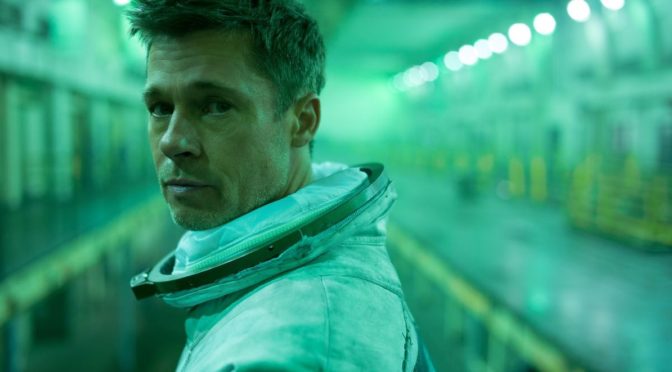As the critic Andrew Chan astutely noted in a review of TWO LOVERS, James Gray’s films ‘pivot on the terror induced by declarations of love’. AD ASTRA is not different, though the scale of the terror has been booted up and beyond New York’s streets or the jungle, out of the stratosphere and beyond even the heliosphere. Gray’s cinema, for all its motifs, perfect shot- and sequence-making, musical movements, and technical daring, is a cinema first and foremost of direct emotional sincerity and force.
After a blast of energy incapacitates the station on which he was working, Roy McBride (Brad Pitt) is brought in for a classified meeting with Space Command. Here, he’s told that this is part of a pattern, and these blasts are referred to as ‘surges’, seemingly caused by the same ship captained by his, long thought deceased, father and space idol H. Clifford (Tommy Lee Jones). His mission is to travel to Mars and send a message to his father, whose ship is positioned somewhere near Neptune’s rings.
“Gray’s cinema, for all its motifs, perfect shot- and sequence-making, musical movements, and technical daring, is a cinema first and foremost of direct emotional sincerity and force.”
But this is not an act of travel into the unknown; quite the opposite, every step of the way seems unerringly familiar. He’s accompanied to the moon by Colonel Pruitt (Donald Sutherland), an old friend of his father’s, the place looking uncomfortably like Earth. The port houses a Virgin Atlantic, a DHL office, and a Subway, and more pointedly, wars rage over disputed territories, interfering with McBride’s task and initiating a lunar buggy chase which outpaces and outclasses Gray’s own moody, convulsive car-sequence in WE OWN THE NIGHT (2008). The trip to Mars is no less personal or complicated or bizarre, especially during a diversion inspired by a research vessel’s mayday call. When on the planet itself, McBride finds base director Helen Lantos (Ruth Negga), who has her own connection to his father’s mission. And beyond, exceeding anyone’s reach, is Roy’s father, whose work prompts a question which only points homeward.
Brad Pitt’s performance combines two requirements of a great star performance: that it enlarges or entrenches the star text as it has been established over the years of an actor’s career, and that it demonstrates a virtuosity of technique. Roy assumes a mask and a role as a steady hand and a cool operator (his pulse supposedly never surpassed 80 BPM before this mission), despite concealing a titanic vault of cathexes beneath the surface. At an early sign of trouble, he twitches just above the nasolabial fold of his left cheek, and it’s the first physical clue to his unsureness. Later, the same psychic hurt is rendered visible by the pulsing of his right eyebrow. But a viewer is already tapped into Roy’s consciousness via a Malickian voiceover, more honest and more strained than his answers in the ‘psychological evaluations’ he constantly submits to; the longer he travels the more he reevaluates his priorities in line with a gradually unfurling trauma, leading to a 2001: A SPACE ODYSSEY (1969) stargate-style breakdown.
“Brad Pitt’s performance combines two requirements of a great star performance…”
The structuring absence is central to AD ASTRA, and there may be more than one. Gray is a director who is beginning to exclude in order to foreground what’s integral but neglected in his characters’ lives. In THE LOST CITY OF Z (2016), Sienna Miller’s Nina yearns for the transcendence her husband achieves, but is deprived the chance. AD ASTRA pushes this exclusion principle to a new extreme. Roy is married to Eve (Liv Tyler), whose time in the film is limited to snatches and snippets. When she’s first on screen, she can only be made out by her vague impression: she’s shot out of focus, clearly expressing the way in which Roy’s sealed off feelings minimise the people in his life. Gray’s also able to sketch important aspects of the world of the film in brief moments, painting a political picture by near omission: Roy was in combat “over the arctic circle”, so an ecological warning is hidden behind the arras of characterisation.
Rumours of production and post-production problems have circled AD ASTRA, meaning that its obvious consistency with Gray’s other films, the definite, unmistakable signature of his work, is all the more miraculous since it must have been hard-won. But that’s the point of auteurism: not the myth of total control, but of personal creation by collaboration (with Max Richter for the score, Hoyte Van Hoytema for the cinematography, Ethan Gross for the script, Kevin Thompson for the production design), or in the case of an antipathetic studio, subtle resistance. Gray’s films have a habit, one no producer could erase, of building towards sublime half-hour finales, or final scenes which rearrange and reconfigure the film you’ve just watched, as in THE IMMIGRANT (2013) and THE LOST CITY OF Z. AD ASTRA, being so linear, instead tries for and finds something his films to date, for all their wonders, have not: catharsis.

